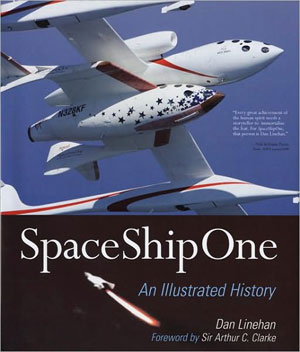Review: SpaceShipOne: An Illustrated Historyby Jeff Foust
|
| It’s likely even those people relatively familiar with the SpaceShipOne effort will learn something new about the development and testing of the spacecraft in SpaceShipOne: An Illustrated History. |
That has changed, though, with the publication of SpaceShipOne: An Illustrated History by Dan Linehan. As the title suggests, the book contains over 200 photos and illustrations, some by the author himself, spanning the development of SpaceShipOne and its series of test flights. Given that, and the book’s oversized format, it may be tempting to dismiss the book as little more than a picture book. That would be an error. Linehan backs up the imagery with some solid research into the project as well as the overall emerging commercial spaceflight field. This includes interviews with many of the key players in the project, including Burt Rutan, Paul Allen, Doug Shane, and test pilots Brian Binnie, Mike Melvill, and Pete Siebold.
The book’s biggest strengths are the chapters devoted to the development of SpaceShipOne and the test flights that followed. In both cases Linehan goes into great detail describing the vehicle’s various subsystems and their development, and then the incremental regime of test flights that eventually led to the vehicle’s flight into space four years ago. While Linehan does provide some background information—he explains, for example, what a hybrid engine is and how it differs from its solid- and liquid-fuel counterparts—he dives deep into the technical details behind that and other subsystems on the vehicle. Likewise, while Scaled published flight logs summarizing each test of SpaceShipOne, Linehan goes into much greater detail about each flight, from the early “captive carry” and glide flights through to the final, prize-winning trip into space.
Given that level of detail, it’s likely even those people relatively familiar with the SpaceShipOne effort will learn something new about the development and testing of the spacecraft in SpaceShipOne: An Illustrated History. (One quibble: parts of the book could have benefitted from an additional round of copyediting to catch typos and other minor errors, like a reference to former NASA administrator “Dan Golden”.) In time this book will be superseded by other books; there is, for example, one behind-the-scenes account of SpaceShipOne’s development yet to be published. And, in time, SpaceShipOne will be superseded by other vehicles, including the SpaceShipTwo that Scaled is developing for Virgin Galactic. Until then, though, there’s SpaceShipOne, and Dan Linehan’s fine book about it.
